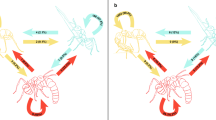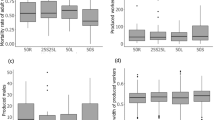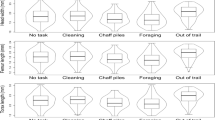Abstract
Some social insects produce workers of variable size and/or shape. One hypothesis to explain such variation is that it increases colony efficiency in performing diverse tasks, with greater efficiency leading to greater colony-level fitness. Using the granivorous ant Messor pergandei, which produces a unimodal distribution of worker sizes, I explored two corollaries of this “ergonomic” hypothesis: that there should be detectable task-matching and that the mean size should shift predictably with a change in task. In five experiments conducted in different years and sites in California deserts, colonies were baited with fragments of wheat or millet ground and sieved to different sizes. In six of eight colonies so baited the minimum linear dimension or mass of seeds carried by foragers was significantly related to forager size, with r2 values ranging from 3 to 30%. In four of the five experiments, colonies were subsequently baited with either large seed fragments alone or small fragments alone. In three of these four experiments I detected a rapid response, over a few hours or days, in which foragers deployed by colonies shifted to larger or smaller mean size in directions predicted by size of the bait. These results suggest that an ergonomic function is one contributor to worker size polymorphism in M. pergandei. Although task-matching did not explain a substantial amount of the variance in forager size in all experiments, the rapid size shifts provide behavioral evidence that task-matching is important to colonies.
Similar content being viewed by others
REFERENCES
Bernstein, R. A. (1975). Foraging strategies of ants in response to variable food density. Ecology 56: 213–219.
Beshers, S. N., and Traniello, J. F. A. (1996). Polytheism and the adaptiveness of worker size variation in the attine ant Trachymyrmex septentrionalis. J. Insect Behav. 9: 61–83.
Brian, M. V. (1979). Caste differentiation and division of labor. In Hermann, H. R. (ed.), Social Insects, Vol. 1, Academic Press, New York, pp. 121–186.
Crosland, M. W. J., Lok, C. M., Wong, T. C., Shakarad, M., and Traniello, J. F. A. (1997). Division of labour in a lower termite: The majority of tasks are performed by older workers. Anim. Behav. 54: 999–1012.
Darwin, C. (1890). On the Origin of Species by Means of Natural Selection, 6th ed., Appleton, New York.
Davidson, D. W. (1978). Size variability in the worker caste of a social insect (Veromessor pergandei Mayr) as a function of the competitive environment. Am. Nat. 112: 523–532.
Ferster, B., and Traniello, J. F. A. (1995). Polymorphism and foraging behavior in Pogonomyrmex badius (Hymenoptera: Formicidae): Worker size, foraging distance, and load size associations. Envir. Entomol. 24: 673–678.
Franks, N. R. (1985). Reproduction, foraging efficiency and worker polymorphism in army ants. In Hölldobler, B., and Lindauer, M. (eds.), Experimental Behavioral Ecology and Sociobiology, Sinauer Associates, Sunderland, MA, pp. 91–107.
Franks, N. R. (1986). Teams in social insects: Group retrieval of prey by army ants (Eciton burchelli, Hymenoptera, Formicidae). Behav. Ecol. Sociobiol. 18: 425–429.
Gordon, D. M. (1996). The organization of work in social insect colonies. Nature 380: 121–124.
Johnston, A. B., and Wilson, E. O. (1985). Correlates of variation in the major/minor ratio of the ant, Pheidole dentata (Hymenoptera: Formicidae). Ann. Entomol. Soc. Am. 78: 8–11.
Oster, G. F., and Wilson, E. O. (1978). Caste and Ecology in the Social Insects, Princeton University Press, Princeton, NJ.
Passera, L., Roncin, E., Kaufmann, B., and Keller, L. (1996). Increased soldier production in ant colonies exposed to intraspecific competition. Nature 379: 630–631.
Rissing, S. W. (1987). Annual cycles in worker size of the seed-harvester ant Veromessor pergandei (Hymenoptera: Formicidae). Behav. Ecol. Sociobiol. 20: 117–124.
Rissing, S. W., and Pollock, G. B. (1984). Worker size variability and foraging efficiency in Veromessor pergandei (Hymenoptera: Formicidae). Behav. Ecol. Sociobiol. 15: 121–126.
Rissing, S. W., and Wheeler, J. (1976). Foraging responses of Veromessor pergandei to changes in seed production. Pan-Pacif. Entomol. 52: 63–72.
Ryti, R. T., and Case, T. J. (1988). Field experiments on desert ants: Testing for competition among colonies. Ecology 69: 1993–2003.
Schmid-Hempel, P. (1992). Worker castes and adaptive demography. J. Evol. Biol. 5: 1–12.
Szathmáry, E., and Maynard Smith, J. (1995). The major evolutionary transitions. Nature 374: 227–232.
Traniello, J. F. A. (1989). Foraging strategies of ants. Annu. Rev. Entomol. 34: 191–210.
Walker, J., and Stamps, J. (1986). A test of optimal caste ratio theory using the ant Camponotus (Colobopsis) impressus. Ecology 67: 1052–1062.
Went, F. W., Wheeler, J., and Wheeler, G. C. (1972). Feeding and digestion in some ants (Veromessor and Manica). BioSciences 22: 82–88.
Wheeler, G. C., and Wheeler, J. (1973). The Ants of Deep Canyon, University of California, Riverside.
Wilson, E. O. (1968). The ergonomics of caste in the social insects. Am. Nat. 102: 41–66.
Wilson, E. O. (1983). Caste and division of labor in leaf-cutter ants (Hymenoptera: Formicidae: Atta). Behav. Ecol. Sociobiol. 14: 47–54.
Wilson, E. O. (1985). The sociogenesis of insect colonies. Science 228: 1489–1495.
Author information
Authors and Affiliations
Rights and permissions
About this article
Cite this article
Waser, N.M. Task-Matching and Short-Term Size Shifts in Foragers of the Harvester Ant, Messor pergandei (Hymenoptera: Formicidae). Journal of Insect Behavior 11, 451–462 (1998). https://doi.org/10.1023/A:1020963000112
Issue Date:
DOI: https://doi.org/10.1023/A:1020963000112




